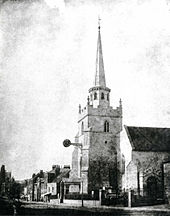Church in Reading, England
| St Giles' Church | |
|---|---|
 The tower of St Giles' Church The tower of St Giles' Church | |
 | |
| 51°27′3.54″N 0°58′13.45″W / 51.4509833°N 0.9704028°W / 51.4509833; -0.9704028 | |
| Location | Reading |
| Country | England |
| Denomination | Church of England |
| Churchmanship | Traditional Catholic |
| Website | sgilesreading.org.uk |
| History | |
| Founded | 12th century |
| Dedication | St Giles |
| Architecture | |
| Functional status | Active |
| Heritage designation | Grade II |
| Administration | |
| Diocese | Diocese of Oxford |
| Archdeaconry | Archdeaconry of Berkshire |
| Clergy | |
| Bishop(s) | Paul Thomas (Provincial episcopal visitor) |
| Rector | David Harris |
| Honorary priest(s) | David Smith |
St Giles' Church is a Church of England parish church in the town of Reading in the English county of Berkshire.
History
St Giles' was one of the three original parish churches, along with St Mary's and St Laurence's, serving the medieval borough of Reading. The church is on Southampton Street, just outside the town centre and in the portion of the original borough to the south of the River Kennet.

The original church was built in the 12th century to serve the population to the south of the River Kennet, who found it difficult to reach St Mary's during winter floods of the river. Besides the southern section of the medieval borough, its parish also included the hamlet of Whitley, which then lay outside the borough boundary. In 1191 Pope Clement III gave the church to Reading Abbey and throughout the Middle Ages it enjoyed the right of sanctuary. In 1539, John Eynon, the then priest of St Giles', was found guilty of high treason and along with Hugh Cook Faringdon, the abbot of Reading Abbey, was hanged in front of the abbey gateway.
During the Civil War, when the Parliamentarian forces besieged Reading, the church tower was garrisoned by the King's forces and used as a gun platform. As a consequence it was in turn attacked by the besieging artillery and the upper part of the tower, including its spire, was destroyed in 1643. The fabric was restored at the end of hostilities.
Soldiers who died in the Battle of Reading (1688) during the Dutch invasion of England in the early part of the Glorious Revolution are buried here.
In 1798 there was a disagreement between members of the congregation of St Giles' Church. Many of them left and founded a new chapel in Castle Street, on the site of Reading's old gaol. This chapel eventually became the Church of St Mary, Castle Street.
In 1872, the original small mediaeval church was rebuilt by James Piers St Aubyn in Early English style retaining only the 13th century aisle walls and Perpendicular style west tower. A new ashlar steeple was added in 1873. The exterior of the church is faced in flint and the roof is tiled. The church is a Grade II listed building.
Present day
The current Rector of St. Giles in Reading is David Harris, a Canadian.
The parish sits within the Anglo-Catholic tradition of the Church of England. As it opposes the ordination of women to the priesthood, St Giles is a member of Forward in Faith and receives alternative episcopal oversight from the Bishop of Oswestry.
References
- ^ "S Giles Church in Reading". PCC of S Giles Church in Reading. Retrieved 28 November 2007.
- ^ "St Giles'". Reading History Trail. Archived from the original on 8 November 2007. Retrieved 28 November 2007.
- Cross, Claire (September 2004). "Cook, Hugh". Oxford Dictionary of National Biography. Oxford University Press. Retrieved 12 June 2009.
- "Reading". New Landscapes. Berkshire Records Office. Retrieved 11 December 2015.
- Childs, W.M. (2003) , "The Story of the Town of Reading", in Ford, David Nash (ed.), The Battle of Broad Street, Nash Ford Publishing, archived from the original on 26 September 2008, retrieved 3 August 2010
- Thorne, James (1847). Rambles by rivers: The Thames. Vol. 1, 2. C. Cox. p. 148.
- "St Mary's Castle Street". Reading History Trail. Archived from the original on 9 November 2007. Retrieved 27 November 2007.
- "Images of England - Church of St Giles and Churchyard Tombs, Southampton Street, Reading". English Heritage. Retrieved 28 November 2007.
- "Who's Who at S Giles". S Giles in Reading. Retrieved 7 July 2016.
- "Reading S Giles, Reading". A Church Near You. Church of England. Retrieved 7 July 2016.
External links
 Media related to St Giles' Church, Reading at Wikimedia Commons
Media related to St Giles' Church, Reading at Wikimedia Commons- Official website
